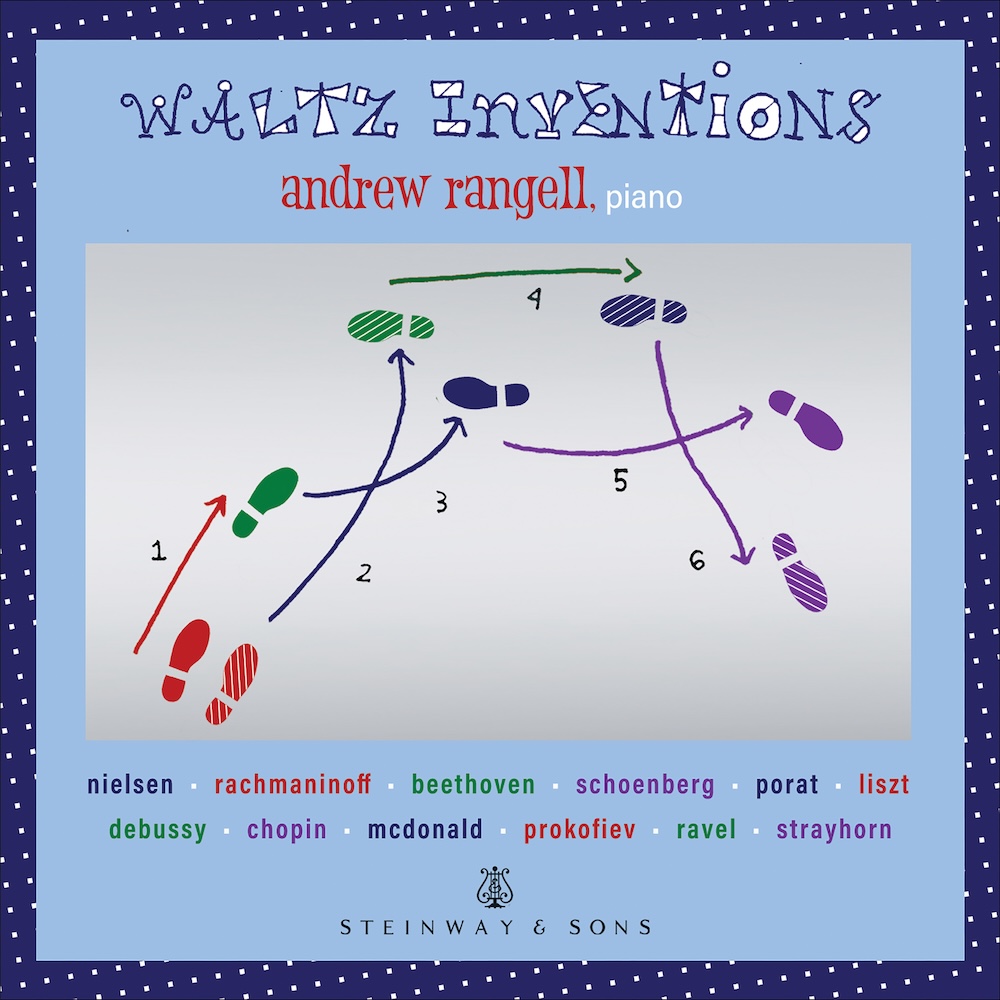Waltz Inventions
Andrew Rangell
Singular pianist Andrew Rangell presents a diverse program of Waltzes on his latest Steinway label release. Ranging from Chopin’s ebullient “Minute Waltz” and Ravel’s masterful “Valses nobles et sentimentales” to an intimate early jewel by Billy Strayhorn, Rangell’s performances are filled with vivacity and emotional depth.

On January 5, 2024, Steinway & Sons releases Waltz Inventions / Andrew Rangell (STNS 30229). As Mr. Rangell writes in his program notes, the album includes Waltzes of different sizes and shapes, styles and strategies, provenance and pedigree. Here are Rangell's brief comments on the program:
Carl Nielsen: Humoresque, Op. 3 No. 2
Spinning Top, Op. 11 No. 2
The early Nielsen pieces (1890-1897), not labelled waltzes, I happily invited under our tent for their Nordic flavor and gripping content. Think of Spinning Top as a sort of Scandinavian Half-Minute Waltz....!
Billy Strayhorn: Valse
Billy Strayhorn was Duke Ellington's beloved collaborator for some three decades. But, while still in high school, in 1933 he composed this soulful Valse, a highly original creation, notwithstanding it's Chopin/Debussy roots.
Kreisler/Rachmaninoff: Liebeslied
Fritz Kreisler's Liebeslied, the violinist's popular Viennese waltz, appeared in print in 1905. In 1931, Rachmaninoff, Kreisler's friend and colleague, lovingly crafted a new solo piano version, his signature imprint evident already in the first few notes of the piece.
Ludwig van Beethoven: Waltz in D major, WoO 85
Waltz in E flat major, WoO 84
Beethoven's most celebrated waltz was Diabelli's, claiming it by framing it! In his last years Beethoven penned two charming baby waltzes (1824-1825), the D major so dinky it forgets to have a middle section, the E flat major possessing a distinctly memorable middle section. Both could pass for (mere) bagatelles...
Arnold Schoenberg: Waltz, Op. 23 No. 5
Schoenberg's Pierrot-esqe waltz, the concluding number of his five Op. 23 piano pieces (1923), is among the very first of the composer's "12-tone" works. (These include all movements of the Suite, Op. 25.) It is a miniature Viennese waltz, graceful, sardonic and somewhat nervous.
Claude Debussy: La Plus que Lente
Debussy's La Plus que Lente (1910) (meaning "more than slow" or "even slower") is his ironic and gorgeous take on the so called "slow-waltz", a genre much in vogue in turn-of-the-century Paris. Underlining his own decadence, Debussy provided the droll marking: "Molto rubato, con morbidezza."
Franz Liszt: Valse Oublieé, S 215 No. 1
Among the introverted and visionary products of Liszt's final years we find the slender, dreamlike Valse Oublieé No. 1 (1881), whose fragmented material gives it a wonderfully incorporeal quality. As a fading memory, it vanishes in a single whispering voice.
Matan Porat: Waltz, for Bill
Written in homage to Bill Evans, Matan Porat's elegantly rambunctious, non-waltz waltz(!) (2008) begins with (and returns to) a happy overarching tune, floated on top of a nervous unstable accompaniment, filled with 5's and 7's. Rarely is triple meter found. Yet the feel of a jazzy, jittery, cooly upbeat waltz is magically produced. No, invented!
Frédéric Chopin: Three Waltzes, Op. 64
Waltz in A minor, Op. 34
The 14 waltzes published during Chopin's life constitute an enduring centerpiece of this genre. The last set to find print (in 1847) was Op. 64, whose waltzes demonstrate a notable economy and concentration of material. The A minor waltz, on the other hand, is an exceptionally probing and expressive creation, written at the age of 21 (in 1831). It quietly demonstrates Chopin's early genius.
John McDonald: Curlique Clip Waltz
John McDonald's tender and charmingly busy Curlique Clip-waltz (2023) is so named for its quintuplet (curlique) embellishments and its exaggerated "Viennese" lifts (clips).
Sergei Prokofiev: Waltz in A major, Op. 65 No. 6
Hearing Prokofiev's tiny "children's" waltz (1935), one smiles at the subtle surprises delicately embedded throughout. A surface of innocence, with very sly undertones. Trademark Prokofiev.
Maurice Ravel: Valses nobles et sentimentales
Ravel's Valses Nobles e Sentimentales, a suite of 8 waltz movements published in 1911, is a distillation of Ravel's devotion to the form, and to Schubert's numerous charming waltzes sharing the same title. Ravel's jeweled waltzes are highly individual, perfectly ordered, and movingly concluded and summarized in a dream-like epilogue replete with fleeting fragments of the preceding waltzes. Ravel being a master inventor.
— Andrew Rangell
“What strikes me immediately about Rangell’s performances is his easeful lyricism and his sunny, joyful interpretation”
Fanfare
“There is much feeling here, strong emotion, but well under control so as to demonstrate the composer's intentions all the better. It's a neat trick, stripping each work to its barest minimum with mathematical precision yet maintaining its poignancy and beauty. But that's Rangell: magisterial and magical.”
Classical Candor
Album Credits
Waltz Inventions / Andrew Rangell STNS 30229
Release Date: 01/05/2024
Recorded July 31 and August 1, 2023 at the Shalin Liu Performance Center, Rockport, Massachusetts
Producer: Andrew Rangell
Recording/Mastering/Editing: Luke Damrosch
Piano Technician: Christine Lovgren
Piano: Steinway Model D #586518 (New York)
Executive Producer: Jon Feidner
Art Direction: Jackie Fugere
Design: Cover to Cover Design, Anilda Carrasquillo
Cover Art: Based on Viennese Waltz steps endorsed by Arthur Murray
Project Coordinator: Renée Oakford
About the Artist
Pianist Andrew Rangell's interpretation of Bach's Well-Tempered Clavier, book 2, released in 2022, brought to completion this pianist's long, loving and comprehensive survey of Bach's keyboard works. Over several decades Mr. Rangell's embrace of Bach has run parallel with other deep involvements, beginning with Beethoven, but also exploring repertoire ranging from Sweelinck, Gibbons, and Farnaby to Ives, Nielsen, Enescu, Schoenberg and a host of other 20th century voices. The pianist’s most recent release featured Schubert’s late G major sonata and Drei Klavierstücke. A forthcoming release will highlight important works by Luigi Dallapiccola and Stefan Wolpe.

Andrew Rangell made his New York debut as winner of the Malraux Award of the Concert Artists’ Guild, and has since performed and lectured throughout the United States, and in Europe, Israel, and China. He has also taught on the faculties of Dartmouth, Middlebury, and Tufts University. In the 1980s, already recognized as a distinctive recitalist and collaborative artist, Mr. Rangell gained national attention – and the award of an Avery Fisher Career Grant – for his vivid traversals of the complete Beethoven sonata-cycle in New York, Boston, Cleveland, Rochester, Denver, and other U.S. Cities. A hand injury sustained in 1991 forced Mr. Rangell to gradually alter the trajectory of his career, and eventually to place his highest priority on recording. In recent years he has created several DVDs for children – integrating his special talents as author, illustrator, narrator, and pianist. These DVDs are included in his albums, Bach 4 Kids and Beethoven 4 Kids, Volumes 1 and 2.
About Steinway & Sons label
The STEINWAY & SONS music label produces exceptional albums of solo piano music across all genres. The label — a division of STEINWAY & SONS, maker of the world’s finest pianos — is a perfect vessel for producing the finest quality recordings by some of the most talented pianists in the world.